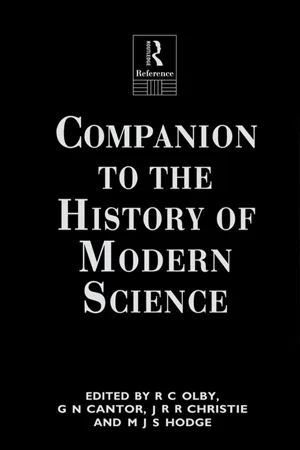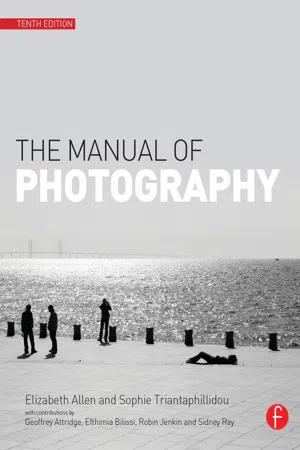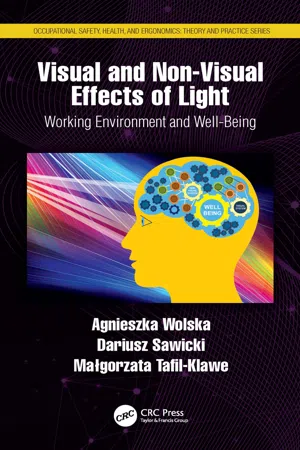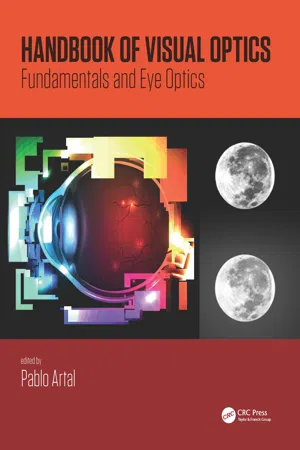Physics
Physics of the Eye
The physics of the eye involves the study of how light is refracted and focused by the various structures of the eye to form an image on the retina. The cornea and lens are the primary refractive elements, while the iris controls the amount of light entering the eye. The retina contains photoreceptor cells that convert light into electrical signals that are sent to the brain for processing.
Written by Perlego with AI-assistance
7 Key excerpts on "Physics of the Eye"
- eBook - ePub
- G N Cantor, G.N. Cantor, J.R.R. Christie, M.J.S. Hodge, R.C. Olby(Authors)
- 2006(Publication Date)
- Routledge(Publisher)
40 Physical Optics G. N. Cantor DOI: 10.4324/9780203191873-471. Introduction
Aristotle understood ‘optics’ to mean the theory of the laws of sight, and for some two millenia the word was generally considered to refer to the study of how we see. Thus, until comparatively recently, lectures and textbooks addressing this subject have been concerned with the problems of visual perception; for example, how distant objects affect our eyes and (thus) our mind, the relationship between the size and situation of an object and its retinal image, the design of optical instruments and the nature of light. The subject matter of optics is thus ill-defined, spilling into areas which we would now call physiology, psychology, engineering, mathematics and physics. Moreover, throughout most of its history, optics cannot be called a discipline since, until the early nineteenth century, there were few textbooks on the subject, no journals and a small and very diverse group of practitioners. At that time, if not somewhat earlier, a more limited definition of the subject emerged, in which optics lost its association with the sense of sight and was instead taken as referring only to the study of the nature and properties of light. It is this definition which present-day physicists will recognise as a branch of their subject.1It is tempting to read the history of physical optics ‘backwards’; indeed, many historians have started with the limited physicists’ definition and then constructed a history linking the views of earlier writers concerning the nature of light. While there has certainly been some continuity within this mode of discourse, there has also been much discontinuity. For example, Descartes’ views about the nature of light cannot simply be understood as a contribution to early physics since his optical theory was framed in response to the wider problem of explaining vision. Moreover, his theory was but part of his reform of natural philosophy, from the foundations upwards. In short, his La dioptrique was but one part of his projected Le monde - eBook - ePub
- Elizabeth Allen, Sophie Triantaphillidou(Authors)
- 2012(Publication Date)
- Routledge(Publisher)
visual cortex, leads us to perceive images approximately one- to two-tenths of a second after they occur. Understanding the basic functioning of the eye leads to better design and operation of imaging systems, whether it be matching the exit pupil of a pair of binoculars to that of the eye or designing a compression system to be perceptually lossless. The visual systems of animals display incredible variation in complexity, operation and performance. Appreciation of this wide biological diversity, from the compound eye of the bee to the polarized vision of cephalopods, inspires many further advances in numerous areas.THE PHYSICAL STRUCTURE OF THE HUMAN EYE
In brief, the eye is a light-tight sphere, approximately 24 mm in diameter, whose shape is predominantly maintained by the sclera, the white part of the eye, and the vitreous humour (Figure 4.1 ). It has a lens system positioned at the front to focus light on to a photosensitive layer, the retina, which lines the rear of the eye, to form an inverted image. The lens system consists of the cornea and a crystalline lens. It is the function of the retina to convert the incoming light to electrical signals which then travel to the visual cortex and other structures via the optic nerve at the rear of the eyeball. Processing of images, their meaning and the context within which they appear is distributed throughout various parts of the brain and not presently fully understood. The visual cortex, however, is primarily responsible for perception of patterns and shapes encoded by the retina. The coloured portion of the eye, the iris, controls the amount of light entering the visual system by changing the size of the pupil - eBook - ePub
Visual and Non-Visual Effects of Light
Working Environment and Well-Being
- Agnieszka Wolska, Dariusz Sawicki, Małgorzata Tafil-Klawe(Authors)
- 2020(Publication Date)
- CRC Press(Publisher)
2 The Biological Bases of Photoreception in the Process of Image VisionA vision is not just a picture of what could be; it is an appeal to our better selves, a call to become something more. Rosabeth Moss Kanter2.1 Optics of the Eye – From the Pupil to the Retina
Numerous studies have been devoted to vision and visual perception in human beings. Though far from easy, it is important to understand the complex and still not entirely discovered workings of sight. The following chapter will try to elucidate the biology of photoreception in the process of image vision.Figure 2.1 provides a diagram showing a schematic cross-section of the human eye (A) and the morphology of the retina (B). Light enters the eye through the cornea (a transparent external surface) and passes through the pupil (the aperture that allows it in). The diameter of the pupil is controlled by the muscles of the iris so that an optimum amount of light can be let in under different conditions. Behind the iris lies the crystalline lens focusing the incoming light on the retina. Thus, the eye can be compared to a photographic camera: it has a variable aperture system (the pupil), a lens system, and a retina that corresponds to the film.FIGURE 2.1 Cross-section of the human eye (A) and morphology of the retina (B).The amount of light entering the eye through the pupil is proportional to its area. The pupil diameter in the human eye can vary from 1.5 mm to 8 mm and is regulated by the iris, whose major function is to admit more light in the dark and less in daylight. The variations in the pupil’s aperture make it capable of allowing 30-fold changes in how much light enters the eye.The lens has just the right curvature for parallel rays of light to pass through each of its parts and be bent exactly enough for all the rays to pass through a single focal point. The more a lens bends the light rays, the greater is its refractive power measured in terms of diopters. In children, this refractive power can be increased from 20 diopters to about 34 diopters, which is an accommodation of about 14 diopters. The elastic lens capsule can change shape (become more or less spherical) in response to the activity of the ciliary muscle, controlled by the autonomic nervous system. This refractive power influences visual acuity, or clarity of vision – in the human eye it is about 25 seconds of arc for discriminating between point sources of light. A person with normal visual acuity looking at two pinpoint light spots 10 m away can barely distinguish the separate spots when they are 1.5 to 2 mm apart. - eBook - ePub
- R.A. Edwards(Author)
- 2014(Publication Date)
- Pergamon(Publisher)
CHAPTER 22The Eye. Defects of Vision and Optical Instruments
Publisher Summary
This chapter focuses on various experimental results related to defects of vision and optical instruments. Image formation, in a good eye, is achieved and perfected by the action of the eye as a whole, namely, cornea, lens, aqueous, and vitreous humors. The angle subtended at the eye lens by the object is the same as that which is subtended by the image at the lens. If the eyeball is of such a length from lens to retina that parallel light from infinity is focused in front of the retina when the ciliary muscles are completely relaxed, short sight, or myopia results. Long sight or hypermetropia is a condition in which the effective power of the eye lens is too small in relation to the length so that when there is no accommodation, parallel light from infinity is focused behind the retina. Presbyopia is the loss of power of accommodation, which is normally associated with the advancing age of an individual. A photographic enlarger is a slightly less elaborate device to the projector. The photographic negative is used in place of a slide and the light-sensitive paper on which the print is to be made takes the place of the screen.22.1 Structure of the Eye
The human eye (Fig. 22.1 ) contains a converging lens L of a gelatinous, transparent material which is not of uniform refractive index throughout and the surfaces of which have different curvatures. The power of the lens is controlled by the ciliary muscles M which act in order to increase the curvature of the lens surfaces. When these muscles are fully relaxed the eye is said to be unaccommodated and it is adjusted for viewing objects at a great distance. When the muscles are fully tensed the eye is fully accommodated for close vision. The point closest to the eye at which an object may be focused clearly when the eye is fully accommodated is called the near point. The distance from the eye of the near point varies considerably from one person to another but is often regarded as being at about 25 cm. The far point is at the greatest distance for which vision is clear when the ciliary muscles are completely relaxed. Ideally this point should be at infinity. The hard, opaque coating of the eyeball, called the sclerotic S , becomes transparent at the front of the eye in order that light may enter. This transparent “window” is called the cornea C . In fact most of the refraction of the light occurs at the cornea, the lens being employed largely for accommodation. Behind the cornea and in front of the lens is the aperture through which light is permitted to enter the lens. This is the pupil P , the size of which is adjusted by a diaphragm called the iris I , which is the familiar coloured part of the eye. The pupil has its largest diameter when illumination is poor, and vice versa. The space A between the lens and the cornea is filled with a salt solution called the aqueous humour . The front of the cornea is also moistened with salt solution and the action of blinking with the eyelids keeps the surface of the cornea clean. The inner wall of the sclerotic at the back of the eye forms the light-sensitive surface R on which the light entering the eye is focused to form images. This surface is called the retina and is covered with light-sensitive cells situated at the ends of nerve fibres which form a network over the surface of the retina and which all leave the the eyeball in a bundle known as the optic nerve O . This leads to the brain which interprets the image on the retina resulting in “sight” or vision. The point at which the optic nerve leaves the eyeball is insensitive to light and is called the blind spot B . In contrast to this is the fovea , or yellow spot Y , at which the retina is most sensitive. This point lies at the intersection of the principal axis of the lens and the retina. The space V between the retina and the lens is filled with a jelly-like substance called the vitreous humour - eBook - ePub
- Pablo Artal, Pablo Artal(Authors)
- 2017(Publication Date)
- CRC Press(Publisher)
1 History of physiological optics in the twentieth century Gerald WestheimerContents
1.1 Status at the beginning of the century 1.2 The foundations 1.3 Structural optics of the eye 1.3.1 Eye dimension and axial length 1.3.2 Cornea 1.3.3 The crystalline lens 1.3.4 Transmission of the ocular media 1.3.5 Retinal optics 1.4 The retinal image 1.4.1 Aberrations of the eye 1.4.2 Quality of the retinal image 1.4.3 Optical transfer function 1.4.4 Strehl ratio 1.4.5 Stray light 1.5 Ophthalmic instrumentation 1.5.1 Ophthalmoscopy 1.5.2 Optometers and automatic objective refractometers 1.6 Spurt at the end of the twentieth century References1.1 STATUS AT THE BEGINNING OF THE CENTURYPhysiological Optics , as confirmed by its central manifestation, Helmholtz’s three-volume handbook, was understood at the time to be synonymous with the current Vision Science . But nomenclature has to go along with the explosive expansion of scientific knowledge. Hence the more optical components are now subsumed under Visual Optics , and even here further subdivision is needed. Optical imagery in the living eye is continually conditioned on factors arising from being embedded in motor apparatuses, specifically those controlling the pupil aperture and the ciliary muscle. Hence a division into structural visual optics , relating to the image-forming properties of the static normal eye, and functional visual optics , which would fold in accommodative and aperture size factors, seems indicated. Though it is not recognized as a distinct discipline, one can identify a branch of research as histological optics - eBook - ePub
Computational Retinal Image Analysis
Tools, Applications and Perspectives
- Emanuele Trucco, Tom MacGillivray, Yanwu Xu(Authors)
- 2019(Publication Date)
- Academic Press(Publisher)
Chapter 3The physics, instruments and modalities of retinal imaging
Andrew R. Harveya ; Guillem Carlesa ; Adrian Bradub ; Adrian Podoleanuba School of Physics and Astronomy, University of Glasgow, Glasgow, United Kingdomb School of Physical Sciences, University of Kent, Canterbury, United KingdomAbstract
Computer analysis of retinal images is of increasing importance in healthcare.The characteristics of retinal images are determined by the physics and principles of the retinal imaging process and hence the appearance of images varies in both profound and subtle ways between imaging modalities. We describe the principles of operation of the main modalities used for clinical retinal imaging, such as the fundus camera, scanning laser ophthalmoscope and optical coherence tomography and discuss the image characteristics that may inform the optimization of algorithms for retinal-image analysis.Keywords
Retinal imaging; Fundus camera; Scanning laser ophthalmoscope; Optical coherence tomography; Retina; Light diffusion; Optics of the eye1 Introduction
The vital importance of the human eye has stimulated an enormous effort into imaging the retina and other parts of the eye to provide clinical diagnostic information on disease and for fundamental research. In this chapter we discuss how the physics underpinning the formation of images of the retina impacts the salient features important for analysis of retinal images.The fascination of the physicist with the eye dates back, at least, to the first gruesome insertion by Newton, in 1665, of a ‘bodkin’ (needle) behind his eye ball [1] . Over the succeeding three-and-a-half centuries we have developed a deep understanding of image formation and vision in the eye. This has included the development of increasingly elaborate imaging systems, originating with the first ophthalmoscopes at the time of von Helmhotz [2] in 1851 and progressing through modern scanning-laser ophthalmoscopes (SLO) for improved contrast and depth sectioning; optical-coherence tomography for imaging the three-dimensional structure of the retina [3] ; to emerging techniques such as adaptive optics that enables the imaging of individual photoreceptors [4] - eBook - ePub
- Hartmut Zabel(Author)
- 2023(Publication Date)
- De Gruyter(Publisher)
11 Physical aspects of visionPhysical properties of the visual system Refractive power of the cornea 43 dpt Refractive power of the lens 15 dpt Combined optical power of the eye (relaxed state for infinite object distance) 58 dpt Average refractive index 1.4 Accommodation width Young: 12 dpt; old: 2 dp Resolving power 3 μm Visual acuity 1’ Intraocular pressure 10–25 hPa Visual field Horizontally: 200°, vertically: 130° Total number of cones 7 × 106 Total number of rods 120 × 106 Density of cones and rods in the fovea Cones: 120 × 103 /mm2 ; rods: 50 × 103 /mm2 Density of cones and rods outside the fovea Cones: 50 × 103 /mm2 ; rods: 120 × 103 /mm2 Spectral range of the eye 400–700 nm Dynamic range of the eye 106 –10−6 cd/m2 Number of muscles controlling the eye ball 9 Number of pigments in a rod/cone 109 Membrane potential of cone/rod in dark state −30 mV Number of layers in the retina 5 Cell types in the retina 6 Thickness of the retina 100–300 μm 11.1 Introduction
It has been estimated that 80% of our sensory information from the environment is perceived through our eyes. The processing of visual perception takes up one-fourth of our brain. Infants’ visual intelligence develops earlier and completes before verbal skills improve. All these facts show how important the visual system is [1 ]. Loss through blindness is a serious handicap.This is the first of two chapters on our sensory system. The next chapter deals with the auditory and vestibular systems. Of course, there are many more senses in our bodies that we constantly draw information from such as pressure, taste, smell, and temperature. The visual and auditory sense are, however, excellent examples of how biology converts physical properties, such as light and sound, into action potentials (APs). The APs are stored and processed in our brain to enable decision-making using memory and experience.As we will notice, visual perception is an extremely complex and intriguing signal transduction. Roughly speaking, one can distinguish three main parts contributing to visual perception: (1) optics of the eye; (2) photon detection and initial image processing within the retina; and (3) signal transmission and further processing in the visual cortex of the brain. This chapter gives a brief overview of mainly the first two parts with some remarks on the third part.
Index pages curate the most relevant extracts from our library of academic textbooks. They’ve been created using an in-house natural language model (NLM), each adding context and meaning to key research topics.
Explore more topic indexes
Explore more topic indexes
1 of 6
Explore more topic indexes
1 of 4






